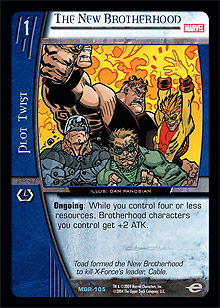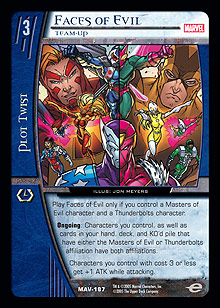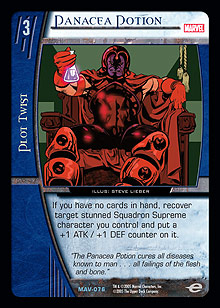
In the last several weeks, I have gone through different Constructed deck archetypes ranging from curve, to off-curve, to combo. This will be the last article in the series dealing with deck archetypes, and it will focus on short-curve decks; these are decks that generally run characters with a cost of 1–5 and top out at turn 5. There are many incarnations of this deck archetype, and it is a very relevant topic considering that Good Guys (a short-curve JLA/JLI deck) is expected to make a large showing at the upcoming Pro Circuit Indianapolis. So sit back, strap in, and get ready for the exciting world of short-curve madness!
TWACK, TWACK, WHAT’S THAT MEAN?
I know I told you last week that I was all out of Pro Circuit San Francisco stories, but I remember one more. I don’t think there are any more after this, I promise. If there is a problem with these stories, just come up to me at Pro Circuit Indy and help me create some new ones!
It was the night after Day 1, and the members of TAWC were on the way to checking out X-Men: The Last Stand. We decided to walk from our 4 ½ star hotel, which we conveniently shared with the Minnesota Twins (all thanks to John Hall and his awesome Marriott hook-ups), over to the theater since it was only three blocks away. As we walked down the street, it was very reminiscent of the scene in Reservoir Dogs where all the robbers are walking out of the coffee shop. Anyway, I digress. While we were walking, this guy started yelling at us, screaming, “Twack, twack, what’s that mean?” I had no clue what he was talking about, and honestly, I was a little frightened. (As big as I am, I am a huge wuss and easily scared.) So I backed away, but John Hall calmly replied, “It means you are illiterate!” I didn’t even realize that we all had on our TAWC shirts and the guy was just reading the letters all jumbled up. So, whenever we are wearing our shirts or just looking for a laugh, we start asking each other what “twack” means!

WHERE DO WE START?
This curve guide is somewhat easy to present. Typically, the normal curve for a short-curve deck will look like the following:
1-drops: 8-10
2-drops: 8-10
3-drops: 4-6
4-drops: 4
5-drops: 4
This skeleton would run anywhere from 28–34 characters. Obviously, its character count can be low at 28, but you have to keep in mind that the count here is largely dictated by what you want out of your deck. You really need to look at the plot twists available to determine where the curve should fall. That, and you should know what you are trying to accomplish (goals . . . again!). Also, knowing the metagame will help you determine exactly when and what types of short-curve decks will be successful.
CHARACTER SELECTION
 Unlike with off-curve decks, your drops don’t have to have dual purposes. Generally it’s nice if they do, but it’s not necessary. Let’s take Squadron Supreme for example. For the most part, all the characters played in that deck (which is featured below) are beaters; they don’t possess any special ability or effect, unless you count getting bigger as you have fewer cards in your hand. Short-curve decks often operate like that. They are generally brought together to maximize a certain concept or ability. For TNB decks, it was to abuse The New Brotherhood and give a global pump to all your characters. For Squadron Supreme, it was to benefit from all the “no cards in hand” bonuses that Squadron has to offer. For Good Guys, it was to abuse the ally ability as many times as possible when using power-ups. As you can see, all three decks are built firmly around a concept, which in turn helps in character selection.
Unlike with off-curve decks, your drops don’t have to have dual purposes. Generally it’s nice if they do, but it’s not necessary. Let’s take Squadron Supreme for example. For the most part, all the characters played in that deck (which is featured below) are beaters; they don’t possess any special ability or effect, unless you count getting bigger as you have fewer cards in your hand. Short-curve decks often operate like that. They are generally brought together to maximize a certain concept or ability. For TNB decks, it was to abuse The New Brotherhood and give a global pump to all your characters. For Squadron Supreme, it was to benefit from all the “no cards in hand” bonuses that Squadron has to offer. For Good Guys, it was to abuse the ally ability as many times as possible when using power-ups. As you can see, all three decks are built firmly around a concept, which in turn helps in character selection.
Seems pretty easy, but it’s not. There is a reason I did not give any other real concrete examples of short-curve decks. At premier-level events, those are the only short-curve decks to break through to those elusive Day 2 matches. What follows is a brief rundown of how, when, and why short-curve decks have been efficient and able to succeed. Hopefully, as we learned in high school, we can learn from history so we won’t be doomed to repeat it.
FROM THE VERY BEGINNING!
While it may not seem like it, short-curve decks have always been around. In fact, I played one at the very first Pro Circuit. I played a build with The New Brotherhood, which ran a techy 4x Blind Sided. The deck was much like I explained above, running a disproportionate number of low drops to high. I piloted a short-curve deck to a 21st place Day 1 finish in the midst of curve-based decks like Common Enemy and complete off-curve decks like Wild Vomit.
So, why did a short-curve deck work in this environment? It had the consistency of an off-curve deck with the power of a curve build. Basically, the best of both worlds. The Common Enemy deck had very specific drops that it had to hit in order to be efficient. On the other side of the coin, the Wild Vomit deck played around twenty copies of Wild Sentinel and sixteen copies of Sentinel Mark IV, which made hitting its specific drops very easy. TNB ran completely differently from either of the two decks I just mentioned. The deck didn’t really have a specific drop that needed to be played each turn. Instead, there were several options. You had the normal drop that fit your curve, but if you didn’t have that, you could underdrop because you had a large number of underdrops. Underdropping like this allowed you to maximize the damage you would do through cards like Savage Land (reusable, so having extra characters meant being able to crack back every turn) and The New Brotherhood (which provided a global +2 ATK). This flexibility and power really made the deck appealing to me and ended up being very beneficial considering that other decks struggled when they didn’t hit their preferred drops. TNB didn’t make a Top 8 appearance at this PC, but it wasn’t for lack of representation. The fact that it didn’t make the Top 8 just reinforces the fact that Draft is as important as Constructed.
THE FALLOUT . . .
The success of Common Enemy really left its impression on the metagame. TNB and short-curve decks in general pretty much fell off the map and were not represented well at the next couple of Pro Circuits. Curve became the deck archetype of choice once Curve Sentinels reared its ugly head. The other most popular deck was Teen Titans, and I would classify it more as a curve deck than a short-curve one, given that it ran 6- and 7-drops and planned to use them. At most premier tournaments, you saw a healthy smattering of those two decks. Pro Circuit New York showed the first signs of a metagame change and had me worried. I was very afraid of a short-curve deck making a big comeback. I had played it before and knew that with the right build, it could be very strong in a good player’s hands. The thought of playing a short-curve Brotherhood deck nearly kept me from playing a Xavier’s Dream deck in New York because Brotherhood packed enough burn and punch to kill me on turn 5 before I got the Dream online. Thankfully, my worries were unfounded, and I didn’t see one Brotherhood deck all day long at PC: New York. I was happy I prepared for it regardless, as being ready for anything means you will be surprised by nothing.
PRO CIRCUIT INDIANAPOLIS, TAKE TWO!
At this PC, the metagame shifted completely. At Pro Circuit New York, the metagame was dominated by Curve Sentinels and Teen Titans. Coming into a DC Modern Pro Circuit guaranteed that decks would be different. However, unlike other Pro Circuits, off-curve was the only way to go. I ended up playing a curve deck, which obviously didn’t work out well for me. Again, short-curve was non-existent for the most part. There were some Emerald Enemy builds that were short-curve decks. Those builds attempted to curve up to 5 and then played down the rest of the game, blowing resources with cards like Femme Fatality and Myrwhydden. Not surprisingly, they struggled tremendously. The benefits given from these cards just were not on the same power level of straight off-curve stuff like Arisia, Oa, or any of the many cards that encouraged attacking up the curve. Also, the off-curve mania was just too fast for a short-curve deck to keep pace.
NOW WHAT?
 Short-curve decks looked like a thing of the past. Even though Brotherhood short-curve builds would occasionally blip on the radar of $10Ks and PCQs, they had unfortunately been absent from the top tables of Pro Circuit events. It seemed as though Vs. System deck archetypes would be forever confined to curve- or off-curve–based decks. Thankfully, the Avengers set brought forth a new era of Vs. System game play. The set successfully re-introduced the curve, short-curve, and off-curve concepts with decks like Avengers reservists, Squadron Supreme, and Faces of Evil. The next Pro Circuit would definitely usher in new deck archetypes.
Short-curve decks looked like a thing of the past. Even though Brotherhood short-curve builds would occasionally blip on the radar of $10Ks and PCQs, they had unfortunately been absent from the top tables of Pro Circuit events. It seemed as though Vs. System deck archetypes would be forever confined to curve- or off-curve–based decks. Thankfully, the Avengers set brought forth a new era of Vs. System game play. The set successfully re-introduced the curve, short-curve, and off-curve concepts with decks like Avengers reservists, Squadron Supreme, and Faces of Evil. The next Pro Circuit would definitely usher in new deck archetypes.
PRO CIRCUIT ATLANTA
This was the first Pro Circuit where short-curve was the dominant deck. The format was defined by Squadron Supreme, which was the deck I took to a second place finish and that ultimately won the whole tournament.
Squadron Supreme (Shane Wiggans)
Characters
4 Albert Gaines ◊ Nuke, Atomic Powerhouse
4 Ape X, Xina
4 Genis-Vell ◊ Photon, Transformed
4 Golden Archer, Wyatt McDonald
4 Joystick, Janice Yanizesh
4 Lady Lark, Linda Lewis
1 Lady Lark, Skylark
4 Melissa Gold ◊ Songbird, Sonic Carapace
4 Shape, Malleable Mutant
Plot Twists
4 Answer the Call
4 Flying Kick
4 Other-Earth
4 Panacea Potion
Locations
2 Rocket Central
Equipment
3 Airskimmer
2 Image Inducer
4 Thunder Jet
 This deck is the epitome of a short-curve deck. It tops out at 5, plays down in a pinch, and packs a heck of a punch. The real reason why it was so unstoppable was Other-Earth. Don’t get me wrong, the deck functions based on the short-curve concept. It pumps out big characters on every drop. If it misses a drop or has a better play, it can immediately adapt like all short-curve decks. That’s what makes it great. But by having great options at every drop, the deck allows you to fully utilize Other-Earth, which was by far the MVP of this Pro Circuit. Squadron Supreme was the most-played deck. For the most part this deck had great matchups across the board and handled the mirror very well. The “no card” concept was and is very powerful. Add to that great support cards like Panacea Potion and Answer the Call, and the deck essentially built itself. You didn’t need to curve up fully because you would have the game in hand on turns 5 and 6. Thus, the deck somewhat gravitated toward a short-curve build, much like TNB did with the four resource restriction from The New Brotherhood. Overall, this deck was expected to do well because of its speed, power, and consistency, and it didn’t disappoint.
This deck is the epitome of a short-curve deck. It tops out at 5, plays down in a pinch, and packs a heck of a punch. The real reason why it was so unstoppable was Other-Earth. Don’t get me wrong, the deck functions based on the short-curve concept. It pumps out big characters on every drop. If it misses a drop or has a better play, it can immediately adapt like all short-curve decks. That’s what makes it great. But by having great options at every drop, the deck allows you to fully utilize Other-Earth, which was by far the MVP of this Pro Circuit. Squadron Supreme was the most-played deck. For the most part this deck had great matchups across the board and handled the mirror very well. The “no card” concept was and is very powerful. Add to that great support cards like Panacea Potion and Answer the Call, and the deck essentially built itself. You didn’t need to curve up fully because you would have the game in hand on turns 5 and 6. Thus, the deck somewhat gravitated toward a short-curve build, much like TNB did with the four resource restriction from The New Brotherhood. Overall, this deck was expected to do well because of its speed, power, and consistency, and it didn’t disappoint.
THE NEW FALLOUT
I half-expected the metagame to follow suit and for short-curve decks become the wave of the future. But with a brand-new Silver Age format looming, the format was wide open. You saw from my “Crystal Ball” article that a combo deck was the most played, but right up there was Good Guys. I personally didn’t play the deck, mainly because the hate was too much for it to overcome in my opinion. The deck I played at Pro Circuit San Francisco ran a lone copy of Kang, Kang Cobra to combat Good Guys, and it served me well, winning me two matches. Again, it seemed like short-curve decks would be the ugly duckling of the Vs. System.
THE UPCOMING PC SEASON
The Pro Circuit at Indianapolis has given me some hope that short-curve will reappear. Most of the hate cards that were present for Good Guys are now out of the format, which makes the deck an early favorite. Not to mention the fact that the deck makes the easiest transition from Silver/Golden to Modern Age, losing very little that can’t be supplanted with newer and arguably better cards. Will there be other decks present? Absolutely. Could there be better decks out there? Again, absolutely. But my money is on Good Guys making a large showing, just going on a hunch and the fact that the last PC where a short-curve deck was expected to be big, it won it all.
IN THE END
I hope that you enjoyed this brief foray into the short-curve archetype. Hopefully the build guide and the history behind it will help you in your deckbuilding efforts. I look forward to seeing which archetypes show up at Pro Circuit Indianapolis. If you see me there, be sure to say hi.
As usual, you can reach me at piercedlawyer@yahoo.com for any questions or comments.